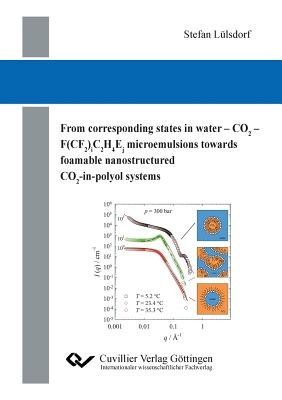
- We will send in 10–14 business days.
- Author: Stefan Lülsdorf
- Publisher: Cuvillier
- ISBN-10: 3736970315
- ISBN-13: 9783736970311
- Format: 14.8 x 21 x 1.2 cm, softcover
- Language: English
- SAVE -10% with code: EXTRA
From corresponding states in water - CO2 - F(CF2)iC2H4Ej microemulsions towards foamable nanostructured CO2-in-polyol systems (e-book) (used book) | bookbook.eu
Reviews
Description
Today there is an increased focus on a considerable reduction of the total energy consumption in the world. As the heating of buildings constitutes a large part of this consumption, the development of highly efficient thermal insulation materials is highly demanded. The most promising class are polymeric nanofoams, which might be producible by using the "Principle Of Supercritical Microemulsion Expansion" (POSME). Within this approach, microemulsions with a high number density of CO2 nano-pools in a polymerizable material (e.g. polyol) are used as templates. Adjusting supercritical conditions, the nucleation of gaseous CO2 during the expansion is avoided, so that each CO2-swollen micelle should ideally grow to a nanopore. However, due to aging phenomena, so far only polyurethane (PU) foams with microcellular pores could be produced applying this approach. In order to improve the properties of the foamable microemulsion template, microemulsions of the type water - CO2 - non-ionic fluorinated surfactant (Capstone(R) FS-3100) were studied in the first part of this thesis as a model system. Small angle neutron scattering (SANS) measurements for the first time revealed the phase inversion from CO2-swollen micelles in water via bicontinuous structures to water-swollen micelles in CO2. Using a scaling description developed for microemulsions of the type water -alkane - CiEj, the temperature dependence of the length scales found in classical and CO2-microemulsions fall on top of each other. Moreover, the partial replacement of CO2 by cyclohexane was found to increase the efficiency of the fluorinated surfactant to form a bicontinuous microemulsion. This efficiency boosting could be correlated with the increase of the bending rigidities κ0, SANS and κNSE determined by SANS and neutron spin echo (NSE). In the second part of this thesis the gained knowledge was successfully used to formulate CO2-in-polyol microemulsions appropriate for the production of nanocellular PU foams. Usi
EXTRA 10 % discount with code: EXTRA
The promotion ends in 20d.17:39:13
The discount code is valid when purchasing from 10 €. Discounts do not stack.
- Author: Stefan Lülsdorf
- Publisher: Cuvillier
- ISBN-10: 3736970315
- ISBN-13: 9783736970311
- Format: 14.8 x 21 x 1.2 cm, softcover
- Language: English English
Today there is an increased focus on a considerable reduction of the total energy consumption in the world. As the heating of buildings constitutes a large part of this consumption, the development of highly efficient thermal insulation materials is highly demanded. The most promising class are polymeric nanofoams, which might be producible by using the "Principle Of Supercritical Microemulsion Expansion" (POSME). Within this approach, microemulsions with a high number density of CO2 nano-pools in a polymerizable material (e.g. polyol) are used as templates. Adjusting supercritical conditions, the nucleation of gaseous CO2 during the expansion is avoided, so that each CO2-swollen micelle should ideally grow to a nanopore. However, due to aging phenomena, so far only polyurethane (PU) foams with microcellular pores could be produced applying this approach. In order to improve the properties of the foamable microemulsion template, microemulsions of the type water - CO2 - non-ionic fluorinated surfactant (Capstone(R) FS-3100) were studied in the first part of this thesis as a model system. Small angle neutron scattering (SANS) measurements for the first time revealed the phase inversion from CO2-swollen micelles in water via bicontinuous structures to water-swollen micelles in CO2. Using a scaling description developed for microemulsions of the type water -alkane - CiEj, the temperature dependence of the length scales found in classical and CO2-microemulsions fall on top of each other. Moreover, the partial replacement of CO2 by cyclohexane was found to increase the efficiency of the fluorinated surfactant to form a bicontinuous microemulsion. This efficiency boosting could be correlated with the increase of the bending rigidities κ0, SANS and κNSE determined by SANS and neutron spin echo (NSE). In the second part of this thesis the gained knowledge was successfully used to formulate CO2-in-polyol microemulsions appropriate for the production of nanocellular PU foams. Usi


Reviews